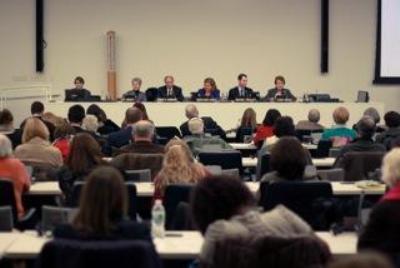|
|
The United Nations Department of Public Information Opens Its 2012 Briefing Season with Culture of Peace!
un articulo por Anne Creter, United for Culture of Peace
What better way for the UN Department of Public Information (DPI) to start 2012 than to kick off 19 January with the potent theme: “Culture of Peace: Amplifying the Unseen and Unheard Voices of Peace.” Surely, it was a dream-come-true -- at least for the United for Culture of Peace (U4CoP) group whose “culture of peace” passion at the UN empowered them to collaborate behind the scene with a delightfully responsive DPI, to make it happen. It seems an omen for the promise of what is yet to come in 2012, as the world shifts towards a culture of peace!

photo by Iris Spelling
click on photo to enlarge
The distinguished panel consisted of Ambassador Anwarul K. Chowdhury – Senior Special Advisor to the UN General Assembly President; Dot Maver, PhD –National Peace Academy President; Michael O’Malley – Soka Gakkai International Program Associate; and Cora Weiss -- Hague Appeal for Peace President. Moderated by DPI Chief, Maria-Luisa Chavez, it began with a moment of silence, in keeping with the spirit of peace, something DPI had never done before.
Ambassador Chowdhury questioned how to “bring in” the Culture of Peace Programme of Action. He hopes everyone reads it in its brochure form, as it “transcends boundaries for eternity.” All UN offices should highlight and support it at the grassroots. Women and youth are essential; and each of us becomes an agent of peace in how we act. He stressed the importance of spirituality and the growing recognition of the “human right to peace.”
Dot Maver inspired with her declaration that peace is sweeping the world. There are so many peace groups in society, it is impossible to name them all. Infrastructures for peace are needed to pull them together (peace ministries, academies, commissions, doctors of peace). 2012 is proving to be a turning point for humanity -- the year to make peace an organizing principle of society.
Michael O’Malley admitted how hard it was at first to understand “culture of peace” because it seemed so abstract. Now he gets that it is about consciousness. He spoke of the new U4CoP group at the UN and its mission to amplify the global movement for the culture of peace, citing launch of its new website that day.
Cora Weiss directed everyone to remember what WWW really stands for -- World Without War! Another UN Resolution is needed to ban nuclear weapons and she would support an Occupy movement to achieve it. Education is key and the Human Right to Peace movement is critical.
A concluding message from Gita Brooke (Operation Peace Through Unity in New Zealand) was read, thanking DPI and all who poured energy into the vision this special Briefing held. Observed by a full house -- along with many unseen - unheard voices actively participating by various social media; webcast to a worldwide audience; and available in archival form, the Briefing seemed to anchor the culture of peace at the UN. The excitement in the room was palpable. Audience questions were exceptional. The positive feedback about it exceeded all expectations.
|








|
DISCUSSION
Pregunta(s) relacionada(s) al artículo :
The new generation, How does it interpret the culture of peace?
* * * * *
Comentario más reciente:
CPNN is pleased to reprint with permission this account of the UN DPI briefing on the culture of peace by Alex Freedman of the Railroad Street Youth Project.
Railroad Street Youth Project brought a contingency of bright-eyed, big-hearted Youth to the UN’s first NGO/DPI briefing of the Year. And what could have been a more appropriate and more inspiring topic for a year of incredible transition and change than “The Culture of Peace.” An expert panel of speakers, including Ambassador Chowdry of Bangladesh, Dorothy Maver, Mike O’Malley of Soka Gokkai International (SGI), and Cora Weiss, each spoke briefly about their views and experiences with Peace – “waging peace”, struggling for peace, working to Build peace, amongst the entrenched and powerful monolithic structures of Violence and War. But most powerful was the crowd that the briefing and the topic itself pulled together: a room full of Future Peacekeepers. It was inspiring to see how many people from so many cultures, talking about Peace and Ending War. Everyone brought positivity, sincerity, compassion, and a sense of urgency. The space truly held the intention of creating peace – all of our personal differences seemed insignificant in the face of such a righteous and pressing Universal need.
The briefing immediately considered the most fundamental of questions: What is peace? There are many definitions, touching on the many different causes, sources, and results of war. One called war “Jealousy of the Old towards the New”, calling attention to the attitude towards Youth and their perspectives and ideas in conflict. Another acknowledged Peace as the recognition that “the Whole is Greater than the Sum of its Parts”, encouraging us to look away from egoism and towards collaboration and cooperation if we wish to build a peaceful society. . ... continuación.

|
|









